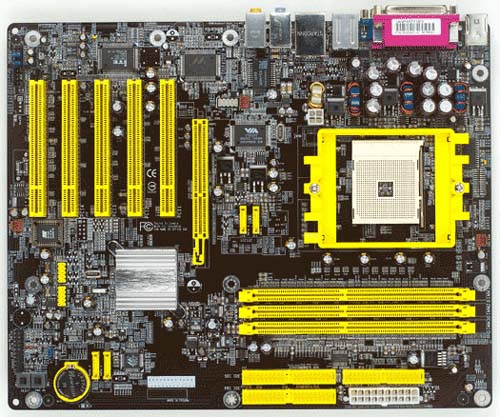Socket 754 Roundup, Part 3: Asus, Soltek & DFI
by Wesley Fink on September 14, 2004 12:03 AM EST- Posted in
- Motherboards
DFI LANParty UT nF3 250Gb: Features and Layout
| DFI nF3 250Gb Motherboard Specifications | |
| CPU Interface | Socket 754 Athlon 64 |
| Chipset | nVidia nForce3-250Gb |
| Bus Speeds | 200MHz to 456MHz (in 1MHz increments) |
| PCI/AGP Speeds | 66MHz to 100MHz (in 1MHz increments) |
| Core Voltage | Auto, 0.8V to 1.55V in .025V increments plus Vid Special multiplier of 4%, 10%, 13%, 23%, 26%, 33%, 36% - TO 2.1V |
| DRAM Voltage | Auto, 2.5V to 3.1V in 0.1V increments (to 3.3V with future BIOS) |
| AGP Voltage | 1.5V-1.9V in 0.1V increments |
| Chipset Voltage | 1.6V-1.9V in 0.1V increments |
| Hyper Transport Ratios | Auto, 1x, 1.5 x, 2 x, 2.5 x, 3 x, 4 x, 5 x |
| CPU Ratios | Auto, 4.0x to 20.0x in 0.5X increments |
| DRAM Speeds | Auto, 100, 120, 133, 140, 150, 166, 180, 200 |
| Memory Slots | Three 184-pin DDR Single-Channel Slots Unbuffered Non-ECC Memory to 2GB Total |
| Expansion Slots | 1 AGP 8X Slot 5 PCI Slots |
| Onboard SATA | 4-Drive SATA by nF3-250Gb |
| Onboard IDE | Two Standard nVidia ATA133/100/66 (4 drives) |
| SATA/IDE RAID | 4-Drive SATA Plus 4-Drive IDE can be combined in nVidia RAID 0, 1, 0+1, JBOD |
| Onboard USB 2.0/IEEE-1394 | 8 USB 2.0 ports supported by nF3-250Gb 2 1394A FireWire ports by VIA VT6307 |
| Onboard LAN | 1 Gigabit Ethernet on-chip by nF3-250GB and Marvel PHY |
| Onboard Audio | Realtek ALC850 8-Channel with UAJ SPDIF coaxial in and out |
| BIOS | Award 8/27/2004 |
We recently did an in-depth review of the DFI in DFI LANParty UT nF3-250Gb: Overclocker's Dream. We have included the tables of features and the DFI photo for easier comparison of the 3 boards. You should refer to the review for detailed information about the DFI LANParty UT nF3-250Gb.

Soltek K8AN2E-GR: Overclocking and Stress Testing
DFI LANParty UT nF3 250Gb: Overclocking and Stress Testing










39 Comments
View All Comments
MemberSince97 - Tuesday, September 14, 2004 - link
Boy, ya sure dont here much noise from FIC these days.MemberSince97 - Tuesday, September 14, 2004 - link
Edit ^^^Mr Fink.........MemberSince97 - Tuesday, September 14, 2004 - link
Good job Mr Finks, Keep on truckin...Wesley Fink - Tuesday, September 14, 2004 - link
Things can change. Ask anyone who has gone from madly in love to a divorce :-)I was very clear that 939 is still faster at the same speed by 2% to 5%. We really expected 939 to make a bigger performance difference than it does when we wrote the pre-939 review. We also had no idea at that point that AMD would keep 939 so much more expensive than 754 and introduce value A64s only in 754 clothes.
I really don't think there is anything inconsistent in our statements. 939 still performs better at the same speed, but many can't or won't pay the current price of 939 admission. 754 can also pass 939 in performance if you can reach higher overclocks with 754.
Wesley Fink - Tuesday, September 14, 2004 - link
#3 - Good luck connecting your IDE cable to a SATA port. I understand your point, but most everyone understands IDE refers to the 40-pin connector.draazeejs - Tuesday, September 14, 2004 - link
Nice article, but I think AT should stay a bit consistent in their statements. Approx. a week before the s939 for A64 was released, they said - wait, do not buy any s754 mobos and CPUs, s939 is the future bla bla bla. Now, 2 months later, they even suggest to buy s754, because the s939 is just by far too expensive at the moment. Money rules the world...Zepper - Tuesday, September 14, 2004 - link
FYI: SATA=IDE, to differentiate, it's SATA and PATA....bh.
Avalon - Tuesday, September 14, 2004 - link
I wonder why the DFI board suffers those two noticeable drops in Specviewperf. Not that Specviewperf is something that matters to me, but it's a bit weird.thebluesgnr - Tuesday, September 14, 2004 - link
Will AnandTech review the ASRock K8 Combo-Z board?